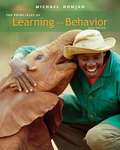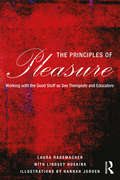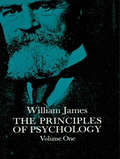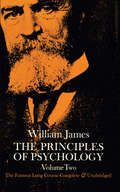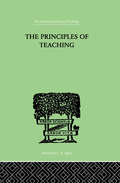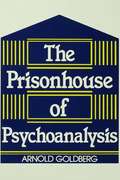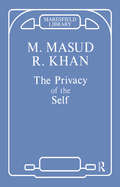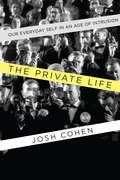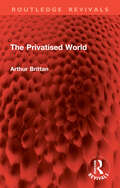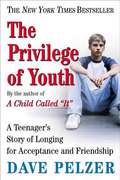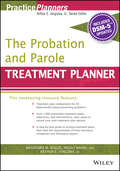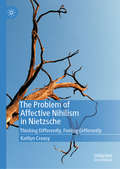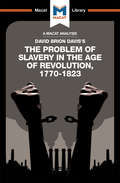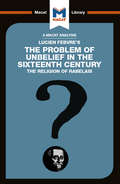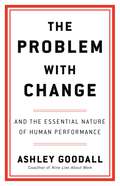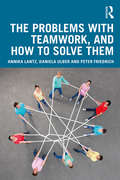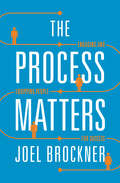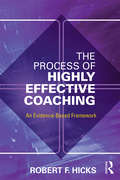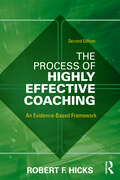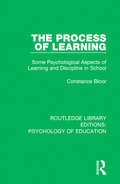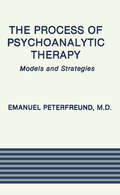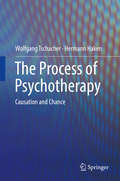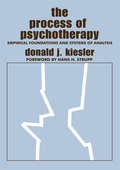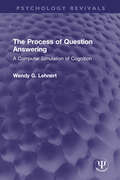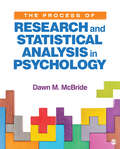- Table View
- List View
The Principles of Learning and Behavior
by Michael DomjanThe book covers habituation, classical conditioning, instrumental conditioning, stimulus control, aversive control, and their applications to the study of cognition and to the alleviation of behavior problems. Biological constraints on learning are integrated throughout the text, as are applications boxes that relate animal research to human learning and behavior. The book closely reflects the field of research it represents in terms of topics covered, theories discussed, and experimental paradigms described
The Principles of Pleasure: Working with the Good Stuff as Sex Therapists and Educators
by Laura Rademacher Lindsey HoskinsThere are tremendous benefits to discussing the subject of sexual and emotional pleasure with clients, and this book addresses the challenges and misconceptions of doing just that. Laura Rademacher and Lindsey Hoskins teach the skills necessary for mental health professionals and sex educators to build competence in this work with their clients. Readers get techniques to implement in therapeutic, clinical, and educational settings, and learn how to examine pleasure in ways that are currently lacking from academic work on sexual health. This book covers skills for working with populations of all orientations and gender expressions. Language and phrasing for addressing pleasure issues in a wide variety of educational or therapeutic settings is also provided. Information about sexual lubrication and sex toys that is rarely taught in professional training programs is included, as well as how to appropriately incorporate information about these important sexual tools into your work. Issues such as abstinence, sexual orientation, couple therapy, and sexual education will be discussed outside of the standard medical model of sex therapy. The Principles of Pleasure will help you feel relaxed and confident while moving clients and students closer to their pleasure goals, and provides the evidence to back up the importance of talking and teaching about pleasure, should you need to justify this work.
The Principles of Psychology, Vol. 1
by William JamesVolume 1 of the famous long course, complete and unabridged. Stream of thought, time perception, memory, experimental methods -- these are only some of the concerns of a work that was years ahead of its time and is still valid, interesting and useful. Total in set: 94 figures.
The Principles of Psychology, Vol. 2
by William JamesThis is the first inexpensive edition of the complete Long Course in Principles of Psychology, one of the great classics of modern Western literature and science and the source of the ripest thoughts of America’s most important philosopher. As such, it should not be confused with the many abridgements that omit key sections.The book presents lucid descriptions of human mental activity, with detailed considerations of the stream of thought, consciousness, time perception, memory, imagination, emotions, reason, abnormal phenomena, and similar topics. In its course it takes into account the work of Berkeley, Binet, Bradley, Darwin, Descartes, Fechner, Galton, Green, Helmholtz, Herbart, Hume, Janet, Kant, Lange, Lotze, Locke, Mill, Royce, Schopenhauer, Spinoza, Wundt, and scores of others. It examines contrasting interpretations of mental phenomena, treating introspective analysis, philosophical interpretations, and experimental research.Although the book originally appeared nearly 75 years ago, it remains unsurpassed today as a brilliantly written survey of William James’ timeless view of psychology.
The Principles of Teaching: Based on Psychology (International Library Of Psychology Ser.)
by Edward L ThorndikeThis is Volume XXXII of thirty-two, in the Developmental Psychology series. Originally published in 1906, the aim of this book is to make the study of teaching scientific and practical—scientific in the sense of dealing with verifiable facts rather than attractive opinions, practical in the sense of giving knowledge and power that will make a difference in the actual work of teaching.
The Prisonhouse of Psychoanalysis
by Arnold I. GoldbergIn The Prisonhouse of Psychoanalysis, Arnold Goldberg trains a searching, critical eye on his own profession. His subject matter is the system of interlocking constraints - theoretical, institutional, educational - that imprisons psychoanalysis and the psychoanalyst. His agenda is to sketch the shape analysis might take in the absence of these constraints. What emerges from these twin endeavors is a penetrating critique of psychoanalysis from the inside - from the vantage point of a senior analyst who has labored for many years within the prisonhouse that he now criticizes. In proffering an alternative vision of psychoanalysis, Goldberg ventures into recent literature in epistemology, philosophy of science, cognitive psychology, and the neurosciences, so that one valuable byproduct of his work is a brilliant application of insights culled from these fields to the question of what analysis is, and what it may yet become. His examination of "psychoanalysis without foundations" challenges the ability of infancy research data and neurological findings, respectively, to provide an empirical rock bottom from which psychoanalytic theory-building can proceed. His chapter on "psychoanalysis without representations" reviews the analytic literature on the latter concept, only to show how recent theories of brain processing, including connectionism, provides a basis for understanding mental phenomena without any intermediary representations. Finally, his vision of "psychoanalysis without a subject" assesses recent findings about the nature of memory, insights of contemporary philosophy, and Kohut's notion of the selfobject as converging tributaries that make possible an analysis that dispenses with the conventional dichotomy of subject and object.
The Privacy of the Self
by Masud KhanThe Privacy of the Self was the first collection of papers showing the development of the author's thinking over twenty five years of clinical work. He was nurtured in the tradition of Anna Freud, John Rickman and D.W. Winnicott, but his contribution to psychoanalytic literature was a distinctive and personal one. What emerges from this book is the natural and private crystallization of his experiences with his patients and teachers.As he says in his preface: "Psychoanalysis is an extremely private discipline of sensibility and skill. The practice of psychoanalysis multiplies this privacy into a specialized relationship between two persons, who through the very nature of their exclusivity with each other change each other. The first thing I wish to say about my work reported in these papers is that my patients have helped me become and personalize my potential of thought, affectivity and effort into a way of life that I find deeply satisfying.
The Private Life: Our Everyday Self in an Age of Intrusion
by Josh CohenWith social networking and reality television, self-help columns and daytime talk shows, there's an infinite array of platforms to both expose our deepest thoughts and examine the thoughts of others. In this age of non-stop communication, one's privacy is subject to unrelenting examination, intrusion, and attack from the media, the government, friends, family, and complete strangers.So what are we trying to hide? And what are we trying to find out about others? Practicing psychoanalyst and professor of literature Josh Cohen tackles those questions in his study of privacy and personality, the "most vulnerable and indestructible region of your self." Using Sigmund Freud's theories on identity and the ego as a foundation, Cohen weaves through time and place to study an extensive variety of people who unearthed and revealed the rawest form of their selves. From Adam and Eve to the ballerinas in the hit 2010 film Black Swan, from Hester Prynne to British celebrity Katie Price, Cohen finds Freud's ideas in both fiction and reality alike.Yet even with all the times that we've exposed the inner workings of our psyches, Cohen is sure to emphasize that some part of every individual will always remain hidden. Like Freud once wrote, "The ego is not master in its own house." In a culture that floods our lives with light, how is it that we remain so helplessly in the dark?
The Privatised World (Routledge Revivals)
by Arthur BrittanUnemployment and the economic crisis are the brutal facts of life in the everyday world around us. For many, the only retreat from this is to the privatized world of the suburbs, middle-class housing estates and high rise developments — a separate world in which the individual often feels entrapped and politically impotent.In The Privatised World (first published in 1978), Arthur Brittan argues that the experience of privatisation in contemporary society is reflected in sociology by the proliferation of social theories which appear to be obsessed with the self and consciousness. Carefully avoiding the pitfalls of a merely autobiographical response, he analyses the phenomenon and concludes that it is precisely because the privatised world does dominate the consciousness of so many people in Western societies that it is difficult to dismiss the partial and pessimistic theories which so many social theorists have employed to explain their predicament.This book will be of interest to students and researchers of sociology and social psychology.
The Privilege of Youth: A Teenager's Story of Longing for Acceptance and Friendship
by Dave PelzerThe #1 New York Times and #1 internationally bestselling author who is a shining example of what overcoming adversity really means now shares the lost chapter of his uplifting journey, which has touched the lives of millions. From A Child Called "It" to The Lost Boy, from A Man Named Dave to Help Yourself, Dave Pelzer's inspirational books have helped countless others triumph over hardship and misfortune. In The Privilege of Youth, he supplies the missing chapter of his life: as a boy on the threshold of adulthood. With sensitivity and insight, he recounts the relentless taunting he endured from bullies; but he also describes the thrill of making his first real friends--some of whom he still shares close relationships with today. He writes about the simple pleasures of exploring his neighborhood, while trying to forget the hell waiting for him at home. The Privilege of Youth bravely and compassionately charts this crucial turning point in Dave Pelzer's life and will inspire a whole new generation of readers. "A monumental series of books about courage and triumph. Pelzer demonstrates, as few have, that it is in the darkest skies that the stars are best seen." -Richard Paul Evans, New York Times bestselling author of The Christmas Box "A living example that all of us have the capability to better ourselves no matter what the odds. Dave Pelzer inspires us all." -Jack Canfield, coauthor of Chicken Soup for the Soul "Dave Pelzer is a living testament to resilience, personal responsibility, and the triumph of the spirit." -John Bradshaw, author of Homecoming and Family Secrets
The Probation and Parole Treatment Planner, with DSM 5 Updates (PracticePlanners)
by Arthur E. Jongsma Jr. Bradford Bogue Anjali NandiThis timesaving resource features: Treatment plan components for 30 behaviorally based presenting problems Over 1,000 prewritten treatment goals, objectives, and interventions—plus space to record your own treatment plan options A step-by-step guide to writing treatment plans that meet the requirements of most insurance companies and third-party payors The Probation and Parole Treatment Planner provides all the elements necessary to quickly and easily develop formal treatment plans that satisfy the demands of HMOs, managed care companies, third-party payors, and state and federal review agencies. Saves you hours of time-consuming paperwork, yet offers the freedom to develop customized treatment plans for clients on parole or probation Organized around 30 main presenting problems, from probation/parole noncompliance and vocational deficits to violent aggressive behavior and childhood trauma, abuse, and neglect Over 1,000 well-crafted, clear statements describe the behavioral manifestations of each relational problem, long-term goals, short-term objectives, and clinically tested treatment options Easy-to-use reference format helps locate treatment plan components by behavioral problem or DSM-5™ diagnosis Includes a sample treatment plan that conforms to the requirements of most third-party payors and accrediting agencies (including HCFA, TJC, and NCQA)
The Problem of Affective Nihilism in Nietzsche: Thinking Differently, Feeling Differently
by Kaitlyn CreasyNietzsche is perhaps best known for his diagnosis of the problem of nihilism. Though his elaborations on this diagnosis often include descriptions of certain beliefs characteristic of the nihilist (such as beliefs in the meaninglessness or worthlessness of existence), he just as frequently specifies a variety of affective symptoms experienced by the nihilist that weaken their will and diminish their agency. This affective dimension to nihilism, however, remains drastically underexplored. In this book, Kaitlyn Creasy offers a comprehensive account of affective nihilism that draws on Nietzsche’s drive psychology, especially his reflections on affects and their transformative potential. After exploring Nietzsche’s account of affectivity (illuminating especially the transpersonal nature of affect in Nietzsche’s thought) and the phenomenon of affective nihilism, Creasy argues that affective nihilism might be overcome by employing a variety of Nietzschean strategies: experimentation, self-narration, and self-genealogy.
The Problem of Slavery in the Age of Revolution
by Duncan Money Jason XidasHow was it possible for opponents of slavery to be so vocal in opposing the practice, when they were so accepting of the economic exploitation of workers in western factories – many of which were owned by prominent abolitionists? David Brion Davis's The Problem of Slavery in the Age of Revolution, 1770-1823, uses the critical thinking skill of analysis to break down the various arguments that were used to condemn one set of controversial practices, and examine those that were used to defend another. His study allows us to see clear differences in reasoning and to test the assumptions made by each argument in turn. The result is an eye-opening explanation that makes it clear exactly how contemporaries resolved this apparent dichotomy – one that allows us to judge whether the opponents of slavery were clear-eyed idealists, or simply deployers of arguments that pandered to their own base economic interests.
The Problem of Unbelief in the 16th Century (The Macat Library)
by Joseph TendlerFebvre asked this core question in The Problem of Unbelief: “Could sixteenth-century people hold religious views that were not those of official, Church-sanctioned Christianity, or could they simply not believe at all?” The answer informed a wider debate on modern history, particularly modern French history. Did the religious attitudes of the Enlightenment and the twentieth century—notably secularism and atheism—first take root in the sixteenth century? Could the spirit of scientific and rational inquiry of the twentieth century have begun with the rejection of God and Christianity by men such as Rabelais, writing in his allegorical novel Gargantua and Pantagruel – the work most often cited as a proto-"atheist" text prior to Febvre's study? The debate hinged on some key differences of interpretation. Was Rabelais mocking the structures of the Christian Church (in which case he might be anticlerical)? Was he mocking the Bible scriptures or Church doctrines (in which case he might be anti-Christian)? Or was he mocking the very idea of God’s existence (in which case he might be an atheist)? <P><P>The other great contribution that Febvre made to the study of history can be found not so much in the fine detail of this work as in the additions that he made to the historian's toolkit. In this sense, Febvre was highly creative; indeed it can be argued that he ranks among the most creative of all historians. He sought to move the study of history itself beyond its traditional focus on documentary records, arguing instead that close analysis of language could open up a gateway into the ways in which people actually thought, and to their subconscious minds. This concept, the focus on "mentalities," is core to the hugely influential approach of the Annales group of historians, and it enabled a switch in the focus of much historical inquiry, away from the study of elites and their deeds and towards new forms of broader social history. Febvre also used techniques and models drawn from anthropology and sociology to create new ways of framing and answering questions, further extending the range of problems that could be addressed by historians. Working together with colleagues such as Marc Bloch, his understanding of what constituted evidence and of the meanings that could be attributed to it, radically redefined what history is – and what it should aspire to be.
The Problem with Change: And the Essential Nature of Human Performance
by Ashley GoodallIf you&’ve had enough of the constant turbulence that defines corporate life today, you&’re not alone. Learn why change is bad for people and for business, and discover how to create the stability that we all need to thrive. For decades, &“disruption&” and &“change&” have been seen as essential to business growth and success. In this provocative and incisive book, leadership expert Ashley Goodall argues that what has become a sacred dogma is both wrong and harmful. Whether it&’s a merger or re-org or a new office layout, change has become the ultimate easy button for leaders, who pursue it with abandon, unleashing a torrent of disruption on employees. The result is what Goodall calls &“life in the blender&”—a perpetual cycle of upheaval, uncertainty, and unease. The problem with change, Goodall argues, is that a culture where everything from people to processes to strategic priorities are constantly in flux exerts a psychological toll that undermines motivation, productivity, and performance. And yet so accustomed are we to constant churn that we have become numb to its very real consequences. Drawing on two decades spent leading HR organizations at Deloitte and Cisco, Ashley Goodall reveals why change is not the same as improvement, and how, by prioritizing team cohesion (instead of reshuffling teams at will), by using real words (rather than corporate-speak), by sharing secrets (not mission statements), by fixing only the things that are truly broken (instead of moving fast and breaking everything in sight, and more, leaders at every level can create the stability that people need to thrive.
The Problems with Teamwork, and How to Solve Them
by Annika Lantz Friedrich Daniela Ulber Peter FriedrichThis book offers practical, evidence-based solutions to help professionals implement and support effective teamwork. Lantz, Ulber and Friedrich draw on their considerable professional experience to present common problems in team-based organizations, what empirical research tells us the causes are and which solutions are more effective in overcoming team-based obstacles. In The Problems with Teamwork, and How to Solve Them, nine common problems are identified, ranging from lack of leadership and adaptability to conflict and cohesiveness, accompanied by clear instructions on how to approach and resolve the individual issues. Detailed case studies are presented throughout the book, demonstrating how theory can be applied to real-life situations to produce optimal results for both the team and the larger organisation. By combining theory and practice, and using state-of-the-art research, the book constructs a cognitive map for identifying problem causes and effect, and step-by-step instructions on how to solve problems. This is essential reading for anyone working in team-based organizations, as well as students and academics in related areas such as organizational psychology and organizational behaviour.
The Process Matters
by Joel BrocknerWe do business in a results-oriented world. Our focus on growth is laudable for its clarity, but one of its downsides is that firms can lose sight of the process: how business gets done and the individuals or employees through whom results are achieved. This leads to compromised decisions and unethical behavior. It is not just what we accomplish that matters but also how we accomplish it. In The Process Matters, Joel Brockner shows that managers have to do more than just meet targets and goals. They have to reach those ends in the right ways--with input, consistency, and accountability--if they want to effectively lead and manage in their organizations. Brockner discusses what goes into the right process, how it leads to better outcomes, why it is easier said than done, and how to overcome obstacles along the way. Brockner demonstrates that a high-quality process often costs little and may not even require a great deal of time. In light of these facts, he considers the puzzling question of why good business practice doesn't happen more often. Brockner draws from various real-life workplace examples--from Jay Leno's departure (twice) from his TV show, to the improvement of shooting accuracy in the U.S. Navy, to the surprising results of layoffs in Canada. He also factors in a wide swath of studies to examine such issues as the importance of perceived fairness in the process, the management of organizational change, and the encouragement of a strong sense of self in those involved in decisions--in short, the ways that managers can bring out the best in their people. Relevant to anyone who is in a managerial position--from the CEO on down--The Process Matters proves that seemingly simple differences in process can go a long way.
The Process of Highly Effective Coaching: An Evidence-Based Framework
by Robert F. HicksThe Process of Highly Effective Coaching offers a unique blend of theory and practical methods for conducting effective coaching conversations. It provides an umbrella under which all of the major conceptual models for helping people change can not only coexist but work together. In addition to using this integrative approach, The Process of Highly Effective Coaching presents a framework for conducting coaching conversations and for relating the coaching process to the coaching competencies defined by the International Coach Federation, the largest coach-credentialing organization in the world.
The Process of Highly Effective Coaching: An Evidence-Based Framework
by Robert F. HicksThe Process of Highly Effective Coaching, 2nd edition, offers a unique blend of theory and practical methods for conducting effective coaching conversations. The book presents a framework for navigating a conversation’s dynamic flow, enabling the practitioner to assimilate information and exhibit the agility of master-level coaches. Additionally, the framework synergistically incorporates the major evidence-based models for achieving client-driven outcomes. This second edition contains fresh content that ties the Foursquare Coaching Framework to the latest information from neuropsychology, leadership, and organizational change.
The Process of Learning: Some Psychological Aspects of Learning and Discipline in School (Routledge Library Editions: Psychology of Education)
by Constance BloorOriginally published in 1930, this book was designed to meet the needs of students in Training Colleges. It is the outcome of first-hand experience of the difficulties encountered by students in the subject of educational theory and its application to the problems of the classroom at the time. It was the hope of the writer that this book may help the student to find a profitable connection between the theory of the lecture room and the problems of the school classroom.
The Process of Psychoanalytic Therapy: Models and Strategies
by Emanuel PeterfreundIn his extensive description of the heuristic approach to psychoanalytic therapy, Peterfreund discusses the strategies used by both patient and therapist as they move toward discovery and deeper understanding.
The Process of Psychotherapy: Causation and Chance
by Hermann Haken Wolfgang TschacherThis book describes an encompassing modeling approach to psychotherapy, created with the most recent research in the field. Therapeutic interventions are staged within a therapist-client relationship ('alliance'), and become effective by the interplay of deterministic ('causation') and stochastic ('chance') forces. The authors use a Fokker-Planck approach complemented by a structural-mathematical framework from complexity theory. Chapters present statistical tools, which can be applied to analyze the differing time series that depict therapeutic processes. Chapters include examples of how to use these tools within research. The approach adopted in the book – contemporary psychotherapy terminology combined with a systems-theoretical model and algorithms for quantitative psychotherapy research – has the potential to become the new benchmark in psychotherapy. The Process of Psychotherapy is an informative and sophisticated resource for all levels of students, from undergraduate through post-doctoral studies, in the fields of psychology, cognitive psychology, and psychotherapy.
The Process of Psychotherapy: Empirical Foundations and Systems of Analysis
by Donald J. KieslerTo understand the process of psychotherapeutic change, one must look for the answers in the psychotherapeutic process itself. This process involves the exchange of communications between two (or more) participants, and as a result of the exchange, modifications in the personality and behavior of the patient are expected to occur. But what is the nature of the therapeutic messages? How do they produce changes in the patient? What aspects of the messages are important for therapeutic change? And if the therapeutic force is somehow encoded in the messages, where shall we look for it- in sentence structure, in emotional overtones, in gestures and body movements? The Process of Psychotherapy is divided into two major parts, dealing respectively with method and with systems. In Part I, the author presents an analysis of psychotherapy process research from a communications perspective, developing an incisive and detailed analysis of the methodological issues that confront researchers in this field and suggesting theoretical and empirical strategies for addressing these issues. Part II provides the first exhaustive and detailed summary of extant psychotherapy process systems. The author first deals with direct systems, those procedures of content analysis or rating scales that have been developed to assess the exchanges between therapists and patients. Seventeen major direct process systems are presented in detail and are summarized with ample citations to the literature. The final section of the book offers an exhaustive listing and concise description of various indirect measures of psychotherapy process, which do not assess the verbatim interview exchanges of the participants in therapy but rather assess the participants' perceptions via self-report or standard analogue procedures. This book is a basic, sophisticated, and exhaustive coverage of psychotherapy process and content analysis that will become the standard and authoritative source for anyone interested in the process of psychotherapy, whether as student, researcher, or practitioner.
The Process of Question Answering: A Computer Simulation of Cognition (Psychology Revivals)
by Wendy G. LehnertOriginally published in 1978, The Process of Question Answering examines a phenomenon that relies on many realms of human cognition: language comprehension, memory retrieval, and language generation. Problems in computational question answering assume a new perspective when question answering is viewed as a problem in natural language processing. A theory of human question answering must necessarily entail a theory of human memory organization and theories of the cognitive processes that access and manipulate information in memory. This book describes question answering as a particular task in information processing. The theoretical models described here have been built on a formulation of general theories in natural language processing: theories about language that were developed without the specific problem of question answering in mind. By requiring programmers to be concerned with the precise form of information in memory, and the precise operations manipulating that information, they can uncover significant problems that would otherwise be overlooked. An early insight into artificial intelligence, today this reissue can be enjoyed in its historical context.
The Process of Research and Statistical Analysis in Psychology
by Dawn M. McBrideThe Process of Research and Statistical Analysis in Psychology presents integrated coverage of psychological research methods and statistical analysis to illustrate how these two crucial processes work together to uncover new information. Best-selling author Dawn M. McBride draws on over 20 years of experience using a practical step-by-step approach in her teaching to guide readers through the full process of designing, conducting, and presenting a research study. The text opens with introductory discussions of why psychologists conduct and analyze research before digging into the process of designing an experiment and performing statistical analyses. Each chapter concludes with exercises and activities that promote critical thinking, the smart consumption of research, and practical application. Readers will come away with a complete picture of the role that research plays in psychology as well as their everyday lives.
